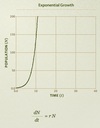Population Flashcards
(60 cards)
Population Ecology
Study of population dynamics, the growth and shrinking of populations in response to changes in abiotic and biotic factors (learning how and why populations grow)
Geometric Population Growth
Growth model for populations with non-overlapping generations and unlimited resources. Only one discrete reproduction event per unit of time for all individuals (individuals added to the population all at once). Successive generations differ in size by a constant ratio.
Finite rate of increase (λ)
The finite rate of increase for a population with non-overlapping generations growing geometically is the ratio of the population size at one time step ( Nt+1 ) to the size of the population at the previous time step ( Nt ). λ = Nt+1 / Nt Usually, the time step used is equivalent to the generation time (e.g., a year for an annual plant). The geometric growth model assumes the population’s growth is not restricted by limiting resources, predation, etc.
If the population grows at a fixed rate, λ will be _____
the same at any time t. The ratio of λ=Nt+1/Nt will be constant.
λ for a shrinking population
0 < λ < 1 (e.g. 0.5)
λ for a growing population
λ > 1
λ for a population with no growth
λ = 1
λ = 1
λ for a population with no growth
λ > 1
growing population
0 < λ < 1
shrinking population
How can you predict the future population size of a geometrically growing population?
Nt = Niλ^t
What are examples of populations that fit a geometric growth model?
Populations with a pulse of “births” (one particular reproduction period per year) where successive generations of a population do not overlap. Many plants, some fish, and ungulates like bison, elk, and wildebeast
Parthenogenesis
Parthenogenesis is known as “virgin birth” since it is the production of offspring without fertilization. Some organisms can reproduce both sexually and asexually. With sexual reproduction, males of the species fertilize the eggs of the females in the usual manner. When reproducing parthenogenetically, females have the ability to effectively clone themselves by developing unfertilized eggs. Parthenogenesis can be a means to rapidly increase population size and/or be a response to take advantage of favorable and stable environmental conditions. The phenomenon occurs most commonly in plants and invertebrates such as aphids, bees, and parasitic wasps. Parthenogenesis is more rarely observed in vertebrates such as lizards and fish.
Nymph
A nymph is an immature life stage of some insects that go through incomplete metamorphosis (known as hemimetabolism). A nymph’s appearance and body form are similar to the adult life stage of the same species, unlike the larval stage of insects that go through complete metamorphosis (holometabolism) which have distinctly different morphology from the adult stage.
Exponential growth
Exponential population growth occurs when there is optimal environmental conditions and overlapping generations/multiple reproduction events. Exponential growth occurs typically only for short periods of time during which necessary resources remain abunant (e.g. introduced new species, many deaths=abundant resources, good environmental conditions). Examples of exponentially growing species include pests, exotics, pioneers, and humans.
The increase in a population’s size is proportional to its current size:
Nt = N0 ert
r is the per capita growth rate. The relationship between r and λ, the finite rate of increase, is:
r = lnλ
The instantaneous rate of change for the population, dN / dt is:
dN/dt = rN
What is the relationship between r and λ?
r = ln(λ)
r for a growing population?
r > 0
r for a shrinking population?
r < 0
r for a population with no growth?
r = 0
Compare r and λ

Intrinsic Growth Rate
The intrinsic population growth rate (or intrinsic rate of increase), symbolized by rmax, is the population growth rate, per individual, for a population with unlimited resources. It is the theoretical maximum value of the per capita growth rate, r.
The per capita growth rate (r) will approach the maximum intrinsic growth rate (rmax) when the environment is completely ideal for the species.
Doubling time
The doubling time of a population td is a constant value for any population growing exponentially.
td = ln(2) / r
td = 0.693 / r
Demographic Transition
Demographic transition is a model that describes changes in human populations over time. As nations develop, industrialize, and become more urban, their populations switch, via stages, from having high birth/death rates to low birth/death rates.
Replacement Level
The replacement level of a population is the rate of reproduction that offsets mortality and maintains a stable population size. In human demography, the replacement level for a couple is considered to be around 2, since two children per couple replaces their two parents in the population after the parents die. If the birth rate of a population is below the replacement level, that population will decline in size through time.





